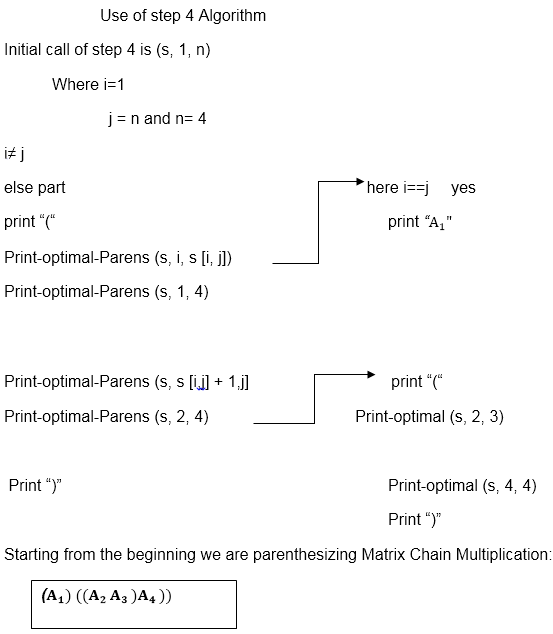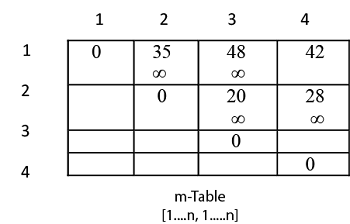Algorithm of Matrix Chain Multiplication
MATRIX-CHAIN-ORDER (p)
1. n length[p]-1 2. for i ← 1 to n 3. do m [i, i] ← 0 4. for l ← 2 to n // l is the chain length 5. do for i ← 1 to n-l + 1 6. do j ← i+ l -1 7. m[i,j] ← ∞ 8. for k ← i to j-1 9. do q ← m [i, k] + m [k + 1, j] + pi-1 pk pj 10. If q < m [i,j] 11. then m [i,j] ← q 12. s [i,j] ← k 13. return m and s.
We will use table s to construct an optimal solution.
Step 1: Constructing an Optimal Solution:
PRINT-OPTIMAL-PARENS (s, i, j) 1. if i=j 2. then print "A" 3. else print "(" 4. PRINT-OPTIMAL-PARENS (s, i, s [i, j]) 5. PRINT-OPTIMAL-PARENS (s, s [i, j] + 1, j) 6. print ")" Analysis: There are three nested loops. Each loop executes a maximum n times.
- l, length, O (n) iterations.
- i, start, O (n) iterations.
- k, split point, O (n) iterations
Body of loop constant complexity
Total Complexity is: O (n3)
Algorithm with Explained Example
Question: P [7,1,5,4,2}
Solution: Here, P is the array of a dimension of matrices.
So here we will have 4 matrices:
A17x1 A21x5 A35x4 A44x2 i.e. First Matrix A1 have dimension 7 x 1 Second Matrix A2 have dimension 1 x 5 Third Matrix A3 have dimension 5 x 4 Fourth Matrix A4 have dimension 4 x 2 Let say, From P = {7,1,5,4,2} - (Given) And P is the Position p0 = 7,p1 =1,p2 = 5,p3 = 4,p4=2. Length of array P = number of elements in P ∴length (p)= 5 From step 3 Follow the steps in Algorithm in Sequence According to Step 1 of Algorithm Matrix-Chain-Order Step 1:
n ← length [p]-1 Where n is the total number of elements And length [p] = 5 ∴ n = 5 - 1 = 4 n = 4 Now we construct two tables m and s. Table m has dimension [1.....n, 1.......n] Table s has dimension [1.....n-1, 2.......n]
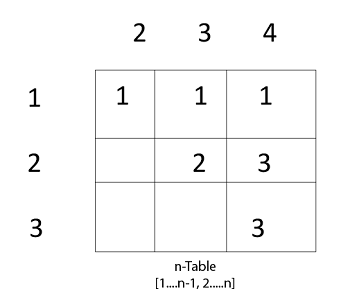
Now, according to step 2 of Algorithm
Case 1:
1. When l – 2
for (i ← 1 to n - l + 1) i ← 1 to 4 - 2 + 1 i ← 1 to 3 When i = 1 do j ← i + l - 1 j ← 1 + 2 - 1 j ← 2 i.e. j = 2 Now, m [i, j] ← ∞ i.e. m [1,2] ← ∞ Put ∞ in m [1, 2] table for k ← i to j-1 k ← 1 to 2 - 1 k ← 1 to 1 k = 1 Now q ← m [i, k] + m [k + 1, j] + pi-1 pk pj for l = 2 i = 1 j =2 k = 1 q ← m [1,1] + m [2,2] + p0x p1x p2 and m [1,1] = 0 for i ← 1 to 4 ∴ q ← 0 + 0 + 7 x 1 x 5 q ← 35 We have m [i, j] = m [1, 2] = ∞ Comparing q with m [1, 2] q < m [i, j] i.e. 35 < m [1, 2] 35 < ∞ True then, m [1, 2 ] ← 35 (∴ m [i,j] ← q) s [1, 2] ← k and the value of k = 1 s [1,2 ] ← 1 Insert "1" at dimension s [1, 2] in table s. And 35 at m [1, 2]
2. l remains 2
L = 2 i ← 1 to n - l + 1 i ← 1 to 4 - 2 + 1 i ← 1 to 3 for i = 1 done before Now value of i becomes 2 i = 2 j ← i + l - 1 j ← 2 + 2 - 1 j ← 3 j = 3 m [i , j] ← ∞ i.e. m [2,3] ← ∞ Initially insert ∞ at m [2, 3] Now, for k ← i to j - 1 k ← 2 to 3 - 1 k ← 2 to 2 i.e. k =2 Now, q ← m [i, k] + m [k + 1, j] + pi-1 pk pj For l =2 i = 2 j = 3 k = 2 q ← m [2, 2] + m [3, 3] + p1x p2 x p3 q ← 0 + 0 + 1 x 5 x 4 q ← 20 Compare q with m [i ,j ] If q < m [i,j] i.e. 20 < m [2, 3] 20 < ∞ True Then m [i,j ] ← q m [2, 3 ] ← 20 and s [2, 3] ← k and k = 2 s [2,3] ← 2
3. Now i become 3
i = 3 l = 2 j ← i + l - 1 j ← 3 + 2 - 1 j ← 4 j = 4 Now, m [i, j ] ← ∞ m [3,4 ] ← ∞ Insert ∞ at m [3, 4] for k ← i to j - 1 k ← 3 to 4 - 1 k ← 3 to 3 i.e. k = 3 Now, q ← m [i, k] + m [k + 1, j] + pi-1 pk pj i = 3 l = 2 j = 4 k = 3 q ← m [3, 3] + m [4,4] + p2 x p3 x p4 q ← 0 + 0 + 5 x 2 x 4 q 40 Compare q with m [i, j] If q < m [i, j] 40 < m [3, 4] 40 < ∞ True Then, m [i,j] ← q m [3,4] ← 40 and s [3,4] ← k s [3,4] ← 3
Case 2: l becomes 3
L = 3 for i = 1 to n - l + 1 i = 1 to 4 - 3 + 1 i = 1 to 2 When i = 1 j ← i + l - 1 j ← 1 + 3 - 1 j ← 3 j = 3 Now, m [i,j] ← ∞ m [1, 3] ← ∞ for k ← i to j - 1 k ← 1 to 3 - 1 k ← 1 to 2
Now we compare the value for both k=1 and k = 2. The minimum of two will be placed in m [i,j] or s [i,j] respectively.
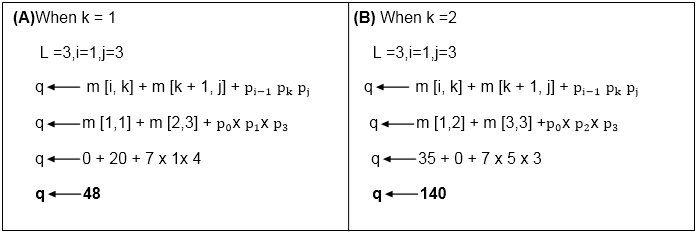
Now from above
Value of q become minimum for k=1 ∴ m [i,j] ← q m [1,3] ← 48 Also m [i,j] > q i.e. 48 < ∞ ∴ m [i , j] ← q m [i, j] ← 48 and s [i,j] ← k i.e. m [1,3] ← 48 s [1, 3] ← 1 Now i become 2 i = 2 l = 3 then j ← i + l -1 j ← 2 + 3 - 1 j ← 4 j = 4 so m [i,j] ← ∞ m [2,4] ← ∞ Insert initially ∞ at m [2, 4] for k ← i to j-1 k ← 2 to 4 - 1 k ← 2 to 3
Here, also find the minimum value of m [i,j] for two values of k = 2 and k =3
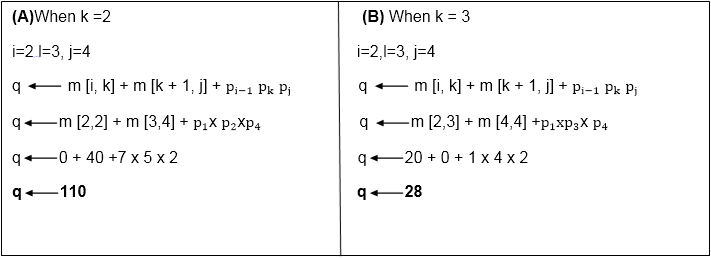
Case 3: l becomes 4
L = 4 For i ← 1 to n-l + 1 i ← 1 to 4 - 4 + 1 i ← 1 i = 1 do j ← i + l - 1 j ← 1 + 4 - 1 j ← 4 j = 4 Now m [i,j] ← ∞ m [1,4] ← ∞ for k ← i to j -1 k ← 1 to 4 - 1 k ← 1 to 3 When k = 1 q ← m [i, k] + m [k + 1, j] + pi-1 pk pj q ← m [1,1] + m [2,4] + p0xp4x p1 q ← 0 + 28 + 7 x 2 x 1 q ← 42 Compare q and m [i, j] m [i,j] was ∞ i.e. m [1,4] if q < m [1,4] 42< ∞ True Then m [i,j] ← q m [1,4] ← 42 and s [1,4] 1? k =1 When k = 2 L = 4, i=1, j = 4 q ← m [i, k] + m [k + 1, j] + pi-1 pk pj q ← m [1, 2] + m [3,4] + p0 xp2 xp4 q ← 35 + 40 + 7 x 5 x 2 q ← 145 Compare q and m [i,j] Now m [i, j] i.e. m [1,4] contains 42. So if q < m [1, 4] But 145 less than or not equal to m [1, 4] So 145 less than or not equal to 42. So no change occurs. When k = 3 l = 4 i = 1 j = 4 q ← m [i, k] + m [k + 1, j] + pi-1 pk pj q ← m [1, 3] + m [4,4] + p0 xp3 x p4 q ← 48 + 0 + 7 x 4 x 2 q ← 114 Again q less than or not equal to m [i, j] i.e. 114 less than or not equal to m [1, 4] 114 less than or not equal to 42
So no change occurs. So the value of m [1, 4] remains 42. And value of s [1, 4] = 1
Now we will make use of only s table to get an optimal solution.
